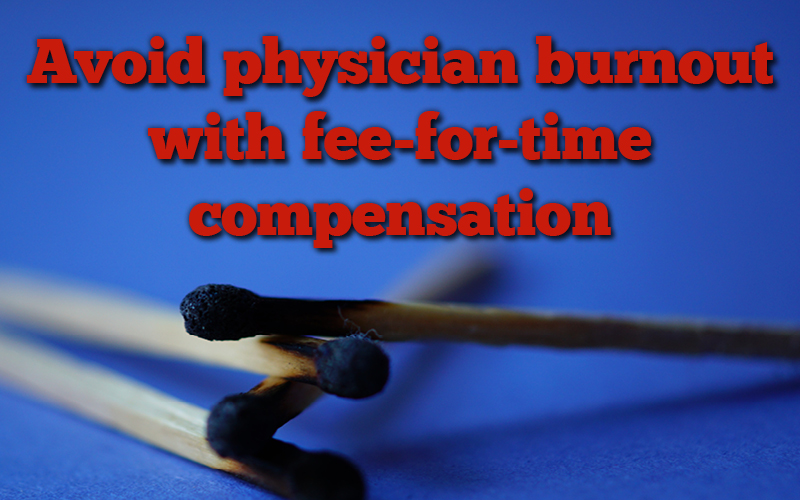Avoid physician burnout with fee-for-time compensation
Do you know a physician who needs a vacation?
Find a coverage solution with fee-for-time compensation arrangements
 Physicians report a high rate of burnout, so it’s especially important to overcome scheduling challenges and prioritize vacations. In other professions taking a much -needed break might be achieved by simply creating an e-mail autoresponder. However, physicians have serious responsibilities to patients and vacations require more thorough planning.
Physicians report a high rate of burnout, so it’s especially important to overcome scheduling challenges and prioritize vacations. In other professions taking a much -needed break might be achieved by simply creating an e-mail autoresponder. However, physicians have serious responsibilities to patients and vacations require more thorough planning.
How is a physician expected to leave town when patients need attention? One often overlooked answer is fee- for- time compensation arrangements formerly known as locum tenens arrangements. The Latin term locum tenens means “one holding a place” and was commonly used until 2017 when a name change occurred with the 21st Century Cures Act .
According to the Medicare Claims Processing Manual “it is a longstanding practice for a physician to retain a substitute physician to take over his/her professional practice when the physician is absent for reasons such as illness, pregnancy, vacation, or continuing medical education, and for such physician (the regular physician) to bill and receive payment for the substitute physician’s services as though he/she performed them.” Medicare also allows a physician who has left the group and for whom the group has engaged a substitute as a temporary replacement to bill for the temporary physician for up to 60 days. But many healthcare providers avoid this solution because they feel unsure about the rules. It’s important to check with state Medicaid offices and consider contracts with third-party payers in addition to Medicare rules. The most recent CMS guidance also addresses coverage for physical therapists. Below are answers to common questions among physicians found within 30.2.11 – Payment Under Fee-For-Time Compensation Arrangements (formerly referred to as Locum Tenens Arrangements) – Claims Submitted to A/B MACs Part B (Rev. 3774, 05-12-17, Effective:06-13-17, Implementation: 06-13-17).
How long can the regular physician be away?
 Medicare restricts the time period to sixty consecutive days. Even if a substitute is only serving in a very part-time situation, it is limited to sixty consecutive days. An exception applies for a physician called to active duty in the Armed Forces. In this case, the provider may bill for services furnished under a fee-for-time compensation arrangement for longer than the 60-day limit. It’s important to note that the regular physician must be unavailable and the absent physician cannot provide care in another setting at the same time.
Medicare restricts the time period to sixty consecutive days. Even if a substitute is only serving in a very part-time situation, it is limited to sixty consecutive days. An exception applies for a physician called to active duty in the Armed Forces. In this case, the provider may bill for services furnished under a fee-for-time compensation arrangement for longer than the 60-day limit. It’s important to note that the regular physician must be unavailable and the absent physician cannot provide care in another setting at the same time.
“EXAMPLE from the Medicare Claims Processing Manual: The regular physician or physical therapist goes on vacation on June 30, and returns to work on September 4. A substitute physician or physical therapist provides services to Medicare Part B patients of the regular physician or physical therapist on July 2, and at various times thereafter, including August 30 and September 2. The continuous period of covered visit services begins on July 2 and runs through September 2, a period of 63 days. Since the September 2 services are furnished after the expiration of 60 days of the period, the regular physician or physical therapist is not entitled to bill and receive direct payment for the services furnished August 31 through September 2. The substitute physician or physical therapist must either bill for the services furnished August 31 through September 2 in his/her own name and billing number or reassign payment to the person or group that bills for the services of the substitute physician or physical therapist. The regular physician or physical therapist may, however, bill and receive payment for the services that the substitute physician or physical therapist provides on behalf of the regular physician or physical therapist in the period July 2 through August 30.”
How is the substitute compensated?
The regular physician generally pays the substitute physician on a per diem or other fee-for-time compensation basis with the substitute physician having the status of an independent contractor, rather than of an employee, of the regular physician. Please be aware that this isn’t a solution for physicians who are new members of a group but lack credentials.
Does the regular physician receive usual reimbursement?
A patient’s regular physician may submit the claim, and (if assignment is accepted) receive the Part B payment, for covered visit services of a substitute physician, if:
- The regular physician is unavailable to provide the services;
- The Medicare beneficiary has arranged or seeks to receive the services from the regular physician
How must claims be submitted?
Claims are submitted under the regular physician’s NPI with the appropriate modifier and the organization must keep a record of each service provided by the substitute with his or her NPI.
According to the Medicare Claims Processing Manual, “Services are billed for the entity as follows:
- The medical group or physical therapy group must enter in item 24d of Form CMS-1500 the HCPCS code modifier Q6 after the procedure code.
- The designated attending physician for a hospice patient (receiving services related to a terminal illness) bills the Q6 modifier in item 24 of Form CMS-1500 when another group member covers for the attending physician.
- A record of each service provided by the substitute physician must be kept on file along with the substitute physician’s NPI. This record must be made available to the A/B MACs Part B upon request. In addition, the medical group physician on whose behalf the services were furnished by a substitute must be identified by his/her NPI in block 24J of the appropriate line item.”
Does the substitute have to be the same specialty?
No, the substitute may be of a different specialty.
Are there compliance requirements?
According to the Medicare Claims Processing Manual, “A/B MACs Part B should inform physicians and physical therapists of the compliance requirements when billing for services of a substitute physician or physical therapist. The physician/physical therapist notification should state that, in entering the Q6 modifier, the regular physician or physical therapist (or the medical group or physical therapy group, where applicable) is certifying that the services are covered visit services furnished by the substitute physician or physical therapist identified in a record of the regular physician or physical therapist which is available for inspection, and are services for which the regular physician or physical therapist (or group) is entitled to submit the claim. A/B MACs Part B should include in the notice that penalty for false certifications may include civil or criminal penalties for fraud, or administrative penalties including revocation of the physician’s or physical therapist’s Medicare billing privileges, right to receive payment, or to submit claims or accept any assignments. The revocation procedures are set forth under 42 CFR 424.535 and in the Medicare Program Integrity Manual (Pub. 100-8).”
When are we prohibited from a fee-for-compensation arrangement?
Fee-for-time compensation arrangements are not a good fit in the following scenarios:
- Coverage for a deceased physician
- Substitute coverage for a regular physician not in good standing (you shouldn’t bill under a physician who lacks good standing)
- Trying out or interviewing a physician you intend to hire
Now that summer is nearing, be proactive in ensuring you have appropriate substitute coverage in place for those physicians that need some time away. For more compliance insight, contact us for a quick demonstration of our comprehensive cloud- based compliance management software solution to help you achieve peace of mind.






